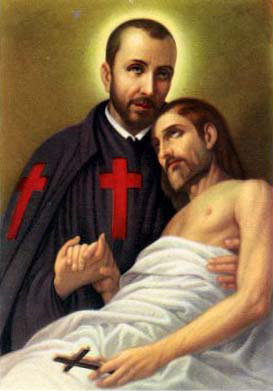Today we continue our regular series called “Learning from the Saints.” Our guide is expert Bert Ghezzi, a dear friend of mine and the author of numerous books including Voices of the Saints, Saints at Heart, and Discover Christ: Developing a Personal Relationship with Jesus.
His more recent books are The Power of Daily Mass and The Heart of Catholicism. You can learn more about Bert and his work at BertGhezzi.com.
Today, Bert profiles St. Camillus de Lellis, the patron of nurses and the sick.
St. Camillus was a giant for his times, standing 6 feet 6 inches tall. He also became a spiritual giant through his unselfish service of the sick.
 At 17 Camillus went with his father to fight against the Turks, and while at war his leg became infected with a serious disease that remained with him for life. He was a rebellious youth, with an addiction to gambling that nearly destroyed him. By age 24 he had literally lost his shirt to gambling. At 25, however, while working at a Capuchin monastery, he responded to a friar’s preaching with radical repentance. He turned his life to Christ and wanted to become a Capuchin, but could not be admitted to the order because of his diseased leg. So he went to work at a hospital for the incurably sick in Rome where he had spent some time when his leg was first infected. There he devoted himself entirely to the care of the sick. The hospital administrators were so impressed with his charity and ability that they appointed him bursar. And to prepare himself to assist the sick spiritually he became a priest.
At 17 Camillus went with his father to fight against the Turks, and while at war his leg became infected with a serious disease that remained with him for life. He was a rebellious youth, with an addiction to gambling that nearly destroyed him. By age 24 he had literally lost his shirt to gambling. At 25, however, while working at a Capuchin monastery, he responded to a friar’s preaching with radical repentance. He turned his life to Christ and wanted to become a Capuchin, but could not be admitted to the order because of his diseased leg. So he went to work at a hospital for the incurably sick in Rome where he had spent some time when his leg was first infected. There he devoted himself entirely to the care of the sick. The hospital administrators were so impressed with his charity and ability that they appointed him bursar. And to prepare himself to assist the sick spiritually he became a priest.
Camillus was appalled by conditions at the hospital and began to surround himself with other young men who were committed to serve the sick. With the support of his adviser, St. Philip Neri, he founded in 1585 the Servants of the Sick, a congregation of male nurses. They pledged themselves to care for the plague-ridden, the sick in hospitals and at home and prisoners. Camillus and his brothers founded and staffed eight hospitals in Italy. In 1595 and 1601 some of them attended the wounded on battlefields in Hungary and Croatia, the first recorded examples of military ambulance units.
Sick and in pain most of the time Camillus himself served without complaint. A member of his order wrote this moving description of the saint:
“I cannot get it out my mind, that when he was attending on a sick person, he looked like a hen with her chickens or like a mother at the bedside of her sick child. For, as if his arms and hands were not enough for the expressions of his affection, he might generally be seen bent over the poor man, as though he wished to communicate to him his heart, his breath, and his very soul.
“Before leaving the bed, too, he would keep smoothing the pillow and gently removing the bedclothes from the sick man’s face and feet and sides. And as if attracted by some invisible lodestone, he seemed as though he could not force himself away. But he hovered about the bed, inquiring how the patient felt, whether he wanted anything else, and giving him some maxim to meditate on for the good of his soul.
“I know not what more the most affectionate mother could have done for her only child in his sickness. No one who did not know the holy father would ever have thought that he had gone to the hospital to serve all the sick without distinction. They would have supposed that all his care was wrapped up in the life of that one poor man and that he had nothing else in the world to think about.”
Camillus championed some avant-garde medical practices, insisting, for example, on proper diet, fresh air and isolation of infected patients. He died in 1614.
Christ’s words, “I was ill and you visited me,” seems to have been engraved on St. Camillus’ heart. He repeated this divine slogan daily, encouraging his brothers to love the sick without thought of themselves.
Adapted from Bert Ghezzi, Voices of the Saints (Loyola Press)
(Image Credit: Catholic.org)
Read more from Bert at his website www.BertGhezzi.com, or check out his many books on Amazon.

